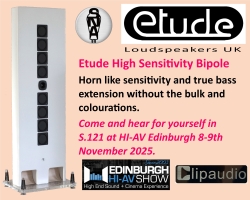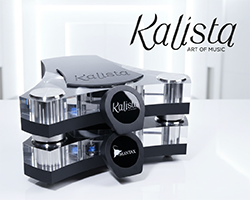Now here is an interesting and well thought out product with a very specific type of buyer in mind.
£3,650 can buy you a lot of DAC these days — Blingy, hewn from solid aluminium billet chassis — internet streaming functionality — fancy numeric displays — remote volume control — selectable digital filters — more inputs and outputs than you can shake a stick at.
And then you have the Longdog Audio VDt1 DAC, which doesn’t do any of that!
Internals ….
It’s designed by valve guru Nick Gorham, and so unsurprisingly uses valves (tubes) in its output stage and power supply. The DAC’s analogue board features two closely matched JAN Philips 5687 triode valves. These are long-lived thermionic devices anyway, but extended life is ensured by the DAC’s automatic standby feature, which powers off the output stage after 5 minutes of digital silence – the blue power LED starts flashing red to indicate this. Power up once digital life is resumed takes about 15 seconds. The DAC circuitry is permanently powered unless the mains power is turned  off using the rear mounted power switch.
off using the rear mounted power switch.
Noise suppression is given high priority in the design with galvanically isolated digital inputs, and the S/PDIF receiver is supplied by three separate ultra low noise voltage regulators. Mechanical vibration is reduced by the solid casework and the 4 RDC2 resonance reduction cone feet used to support the chassis. The chassis casing and base are aluminium to eliminate the production and transmission of earth current loops.
Three regulated power supplies are provided;- for the digital board main supply, the output stage valve heater supply, and a valve-regulated high voltage supply using MOSFETs and an EF86 pentode valve.
Digital processing is handled by an Asahi Kasei AK4396 DAC chip, chosen by Nick Gorham as the best sounding device for the application.
Externals ….
The front panel knob selects between three inputs (two coaxial and one USB) and below this there’s a vertical column of LEDs indicating power, error status, and DSD and HS Coax signal detection. The HS Coax indicator lights up when the coaxial input sees 88.2kHz sample rates or higher, but sadly doesn’t tell you the precise sample rate, which might be a bit frustrating as you can sometimes not be quite sure what the sample rate is with computer audio – and obsessive types like me, and maybe you, like to know!
Either of its two coaxial digital input sockets can be configured as Toslink or XLR inputs to special order, or the high quality silver plated RCA audio outputs changed for XLRs. The black chassised DAC is available with silver or black front fascia.
 The power LED flashes for about 15 seconds while the output stage is warming up, the unit then becomes operational.
The power LED flashes for about 15 seconds while the output stage is warming up, the unit then becomes operational.
Is it for you? ….
The afore-mentioned “very specific buyer” is one who places sound quality at the very top of their list of buying criteria.
No, fear not, it isn’t a hair shirt, thin chassised, poorly implemented hodgepodge that looks like it’s been bolted together in a musty backstreet garage using budget components from who knows where. It is solidly made, with well designed and beautifully laid out internals, and uses very high quality components and socketry. No fancy bells or whistles, it just takes in PCM and DSD 64 digital audio signals and outputs high quality analog audio.
Distribution is handled by David Brook at Mains Cables R Us. He provides a 30 day money back guarantee, allowing you to try it out in your own system for an extended period. If it does not suit you just return it for a refund. You cannot say fairer than that!
You do have to be a bit careful with the choice of interconnect cables from the DAC. To start with, I just used my regular standby RCA cables – Whoa! – what’s happening here? The imaging was vague in the extreme, lacking focus and tangibility – it sounded like the speaker cables were wired out of phase. Seriously strange. I actually returned the DAC to the distributor as faulty. Another LDA VDt1 DAC arrived – the same thing happened! Oh no, what on earth can I have done?! Distinctly uncomfortable with the whole thing I got back to the distributor again — who contacted Nick Gorham — who replied along the lines of “ah, yes, you must use interconnects that are grounded at both ends or the DAC’s circuit can behave very strangely”. A suitable pair of cables was supplied and all was well.
You do have to watch out for this. This has nothing to do with the sometimes contentious issue of “cable sound”, it’s to do with the DAC’s circuit itself.
I must have weird cables! – David Brook at MCRU had not come across this issue before.
Sonically ….
If you’ve read this far, you will know if the concept interests you and if it will suit your needs in terms of functionality.
So, how does it sound?
Explicit and quite bold. Dynamic and exciting. Transparent, focused and detailed.
It isn’t everyone’s cup of tea, I am sure. But I like it. I like it a lot.
The LDA VDt1 DAC isn’t for those listeners who want to be cuddled by the music, who want to languish in a broad wash of enveloping warmth. It’s for those who really, truly want to know quite specifically what is on the recording but without a fatigue-inducing barrage of over-etched hyped-up detail.
Melvin Taylor’s earthy vocals are startlingly present, and the funk and drive of the Slack Band is hugely, hugely  enjoyable. I really haven’t heard this done better, usually nowhere near as good!
enjoyable. I really haven’t heard this done better, usually nowhere near as good!
No, it is not stark or sterile by any means. But it provides a listening perspective from near the front of the arena, a few rows back from the platform in the front stalls of a concert hall. It presents music in a way that is fairly up front and personal, it really doesn’t do the background listening thing. To listen through it is to be involved in the intricacies of the music making.
There are DACs around with an even bolder, more incisive musical view, with faster and harder hitting transients, and slammier bass. And some music can sound more impressive when presented this way. The VDt1 DAC’s presentation isn’t extreme, but overall it is on the incisive and explicit side of the presentation spectrum.
Tonally it is quite neutral. Treble is lucid and extended, but vocal sibilance is not emphasised. Bass is well defined and powerful, and just a little on the full and warm side rather than dry and taut.
The tunef ul, driving joie de vivre of Porcupine Tree’s In Absentia is excitingly captured, the rhythmic swagger engagingly caught.
ul, driving joie de vivre of Porcupine Tree’s In Absentia is excitingly captured, the rhythmic swagger engagingly caught.
Vocals have an in-the-room natural presence that I find very enjoyable indeed.
The luscious Barbara Bonney sounded exqusitely sad and whistfully beautiful in Henry Purcell’s infinitely touching ‘When I Am Laid In Earth’ on her Fairest Isle album.
…. and Susanna Wallumrod’s was there in the room with me with her beautifully recorded and fascinatingly depressing suicidal compilation of her own songs and some by Nick Drake, Leonard Cohen and John Dowland on ECM’s If Grief Could Wait. Wow.
 Totally yummy — just make sure that any sharp implements are safely secured away!
Totally yummy — just make sure that any sharp implements are safely secured away!
Soundstaging is impressively 3D, well separated in depth as well as laterally. Very focussed with realistically rounded and solid images – not over-etched, just natural. Without doubt among the very best digital soundstaging I have heard. Often I am tempted to dig out my “great soundstaging” recordings to see what a component can do. That’s not really necessary with the LDA DAC – so many recordings are simply allowed to blossom into a naturally presented acoustic.
In retrospect ….
As I type this paragraph, the DAC has been gone now for a few days and I’m looking back over my notes and the mostly-complete draft of this review.
I’m feeling a bit uncomfortable about it, actually. I like to provide a ‘balanced’ view of a component’s sonic performance — it’s good at this, about average at that, but I’ve heard much better in this regard. Hmm. I haven’t really done that with the LDA DAC. I think it is up there with the very best DACs I have heard, and in the absence of clearly superior competition it’s quite difficult to criticise it.
It does have a ‘character’ lying a little to the explicit side of the presentation spectrum, but I heard no particular faults as such. Yes, you can get a more ‘extreme’ presentation in terms of incisive detail, for example, and slammier / tauter bass. Or you can go in the other direction and get a more relaxed presentation, music painted with a broader brush. And I guess some folks would prefer that.
In Summary, the LDA VDt1 is a fine, musically engaging and natural sounding DAC. It’s not overflowing with features or functionality, but it can be tailored to meet your needs when you order it. In terms of appearance, it doesn’t really do the Pride of Ownership thing. It just plays the music and sounds genuinely excellent. I could easily live with this DAC. That’s a very strong recommendation from me. If you’re in the market for a great sounding DAC in the “several £k” sort of price range, get yourself an audition!
______
Review system: MBL 116F speakers, Krell KAV-250a power amp, Restek Consens active and Glasshouse passive pre-amps, Vincent CD S7 & McCormack UDP-1 CD Players.
Author – Jerry


















































































































































































































You must be logged in to leave a reply.